The NVIDIA GeForce RTX 2080 Ti & RTX 2080 Founders Edition Review: Foundations For A Ray Traced Future
by Nate Oh on September 19, 2018 5:15 PM EST- Posted in
- GPUs
- Raytrace
- GeForce
- NVIDIA
- DirectX Raytracing
- Turing
- GeForce RTX
Power, Temperature, and Noise
With a large chip, more transistors, and more frames, questions always pivot to the efficiency of the card, and how well it sits with the overall power consumption, thermal limits of the default ‘coolers’, and the local noise of the fans when at load. Users buying these cards are going to be expected to push some pixels, which will have knock on effects inside a case. For our testing, we use a case for the best real-world results in these metrics.
Power
All of our graphics cards pivot around the 83-86W level when idle, though it is noticeable that they are in sets: the 2080 is below the 1080, the 2080 Ti sits above the 1080 Ti, and the Vega 64 consumes the most.
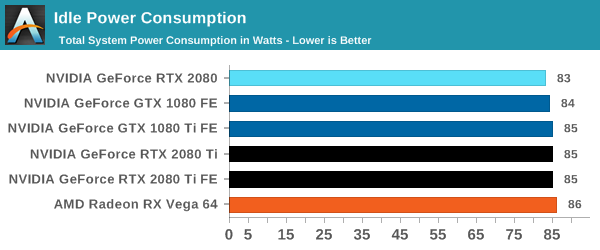
When we crank up a real-world title, all the RTX 20-series cards are pushing more power. The 2080 consumes 10W over the previous generation flagship, the 1080 Ti, and the new 2080 Ti flagship goes for another 50W system power beyond this. Still not as much as the Vega 64, however.
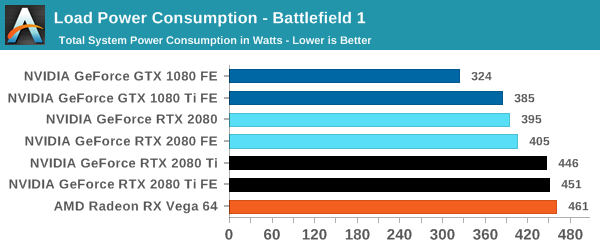
For a synthetic like Furmark, the RTX 2080 results show that it consumes less than the GTX 1080 Ti, although the GTX 1080 is some 50W less. The margin between the RTX 2080 FE and RTX 2080 Ti FE is some 40W, which is indicative of the official TDP differences. At the top end, the RTX 2080 Ti FE and RX Vega 64 are consuming equal power, however the RTX 2080 Ti FE is pushing through more work.
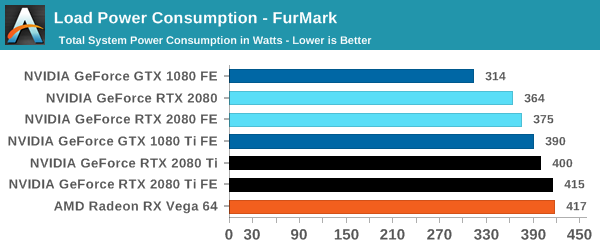
For power, the overall differences are quite clear: the RTX 2080 Ti is a step up above the RTX 2080, however the RTX 2080 shows that it is similar to the previous generation 1080/1080 Ti.
Temperature
Straight off the bat, moving from the blower cooler to the dual fan coolers, we see that the RTX 2080 holds its temperature a lot better than the previous generation GTX 1080 and GTX 1080 Ti.
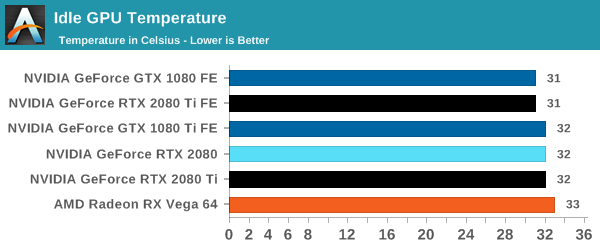
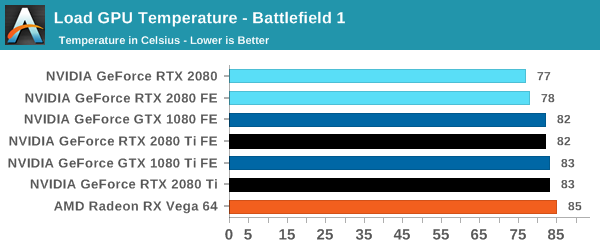
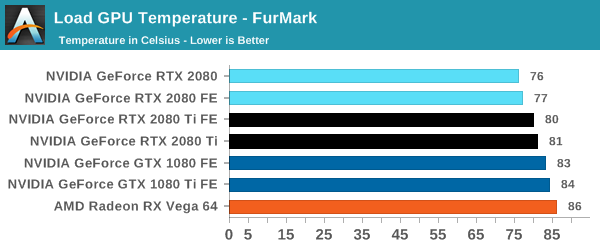
At each circumstance at load, the RTX 2080 is several degrees cooler than both the previous generation and the RTX 2080 Ti. The 2080 Ti fairs well in Furmark, coming in at a lower temperature than the 10-series, but trades blows in Battlefield. This is a win for the dual fan cooler, rather than the blower.
Noise
Similar to the temperature, the noise profile of the two larger fans rather than a single blower means that the new RTX cards can be quieter than the previous generation: the RTX 2080 wins here, showing that it can be 3-5 dB(A) lower than the 10-series and perform similar. The added power needed for the RTX 2080 Ti means that it is still competing against the GTX 1080, but it always beats the GTX 1080 Ti by comparison.
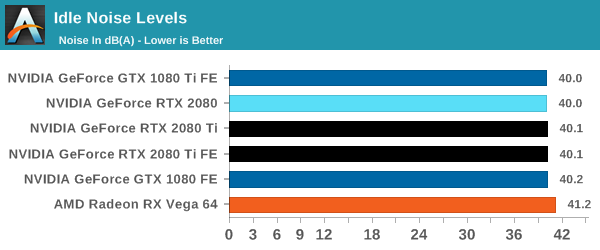
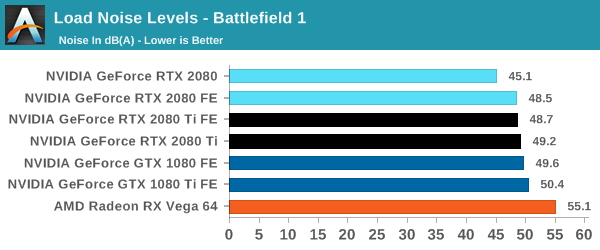
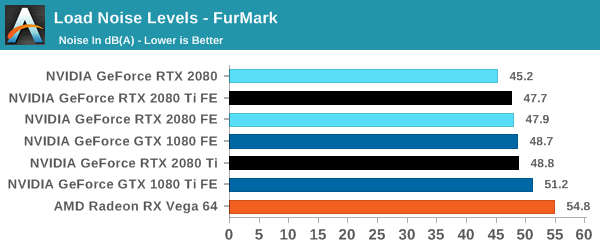










337 Comments
View All Comments
milkod2001 - Thursday, September 20, 2018 - link
NV is messing with us. Even with no competition from AMD those price hikes at such low performance gains are laughable. This generation of new GPU seems like just a stop gap before NV will have something more serious to show next year.willis936 - Thursday, September 20, 2018 - link
No they seem like they will be exactly the same as the 1000 series: they are what they are, you pay what they ask, and they will be the only decent option they offer for the next two years.Maybe if Radeon ever gets their shit together the landscape might look different in 2-3 years but trust me: for now, expect more of the same.
milkod2001 - Thursday, September 20, 2018 - link
Yeah we are pretty much getting into Intel vs AMD scenario when Intel dominates for a years and bring customers overpriced products with very slow performance upgrades. There is a hope AMD will at least try to do something about it.yhselp - Thursday, September 20, 2018 - link
The temperature and noise results are shocking. The results are much closer to what you'd expect from a blower, rather than an open-air cooler. Previous gen OEM solutions do much better than this. What's the reason for this?milkod2001 - Thursday, September 20, 2018 - link
Chips are much bigger than previous gen.iwod - Thursday, September 20, 2018 - link
I think we need DLSS and Hybrid Ray Tracing to judge whether it is worth it. At the moment, we could have the nearly double the performance of 1080Ti if we simply have a 7xxmm2 Die of it.I think the idea Nvidia had is that we have reached the plateau of Graphic Gaming. Imagine what you could do with a 7nm 7xxm2 Die of 2080Ti? Move the 4K Ultra High Quality frame rate from ~60 to 100? That is in 2019, in 2022 3nm, double that frame rate from 100 to 200?
The industry as a whole needs to figure out how to extract even more Graphics Quality with less transistors, simpler software while at the same time makes 3D design modelling easier. The graphics assets from gaming are now worth 100s to millions. Just the asset, not engine programming, network, 3D interaction etc, nothing to do with code. Just the Graphics. And Hybrid Ray tracing is an attempt to bring more quality graphics without the ever increasing cost of Engine and graphics designer simulating those effect.
What is interesting is that we will have 8 Core 5Ghz CPU and 7nm GPU next year.
Chawitsch - Thursday, September 20, 2018 - link
Given how much die space is dedicated to the new features software support will definitely be the key for these cards' success. Otherwise their price is just too high for what they offer today. Buying these cards now is somewhat of a gamble, but nVidia does have excellent relations with developers however, so support should come. As someone who would like to have a capable GPU for 100+ FPS gaming at 1440p, especially one that is future proof, I would much rather take my chances with these new cards.To me the question is this, would it really be worth focusing even more on 4k gaming, when it is a fairly niche market segment still due to monitor prices (especially ones with low latency for gaming). Arguably these high end cards are niche too, but when we can already have 4k@60 FPS, with maxed graphics settings, other considerations become more important. At any given resolution and feature level pure performance becomes meaningless after a certain point, at least for gaming. Arguing that reaching 100 FPS at 4k definitely has merit in my opinion, but by the time really good 4k monitors take over we'll get there, even with the path nVidia took.
Regarding graphics quality and transistor count, ray tracing should be a win here, if not now in the future certainly. There are diminishing returns with rasterization as you approach more realistic scenes and ray tracing makes you jump through less hoops to if you want to create a correct looking scene.
MadManMark - Thursday, September 20, 2018 - link
"I think the idea Nvidia had is that we have reached the plateau of Graphic Gaming. Imagine what you could do with a 7nm 7xxm2 Die of 2080Ti?"Yes, but that is probably why they stuck with 12nmFF actually. Note the die size, plus each card has its own GPU, rather than binned selection from the same GPU (kudos to Nate for also ruminating briefly on this in text). This means maximizing yiled is particularly important, and so begs for a mature, efficient process. TSMC achieved great things with their current 7nm process, no knock on it, but it is still UV-based, it's been long documented that there are yield challengels with that. IMO Nvidia will wait to hitch their wagons to TSMC's next process (expected next year), EUV-based 7nm+, which is expected to mitigate a lot of these yield concerns.
In other words it will be very interesting to see what the 2180 Ti looks like next year -- yes, I built a lot of assumptions into that sentence ;)
eddman - Thursday, September 20, 2018 - link
Come on, the naming is already set; 1080, 2080, 3080. What the hell is a "2180"?P.S. OCD
Lolimaster - Saturday, September 22, 2018 - link
That works if you expect graphics to be stagnant, tons of mini effects and polygon count will chunk a current 1080ti to 10fps in 2021.